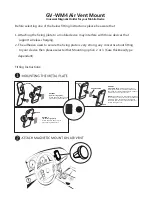
8
Warnings
• Do not use the
biosensor during
MRI procedures.
The biosensor is MRI unsafe.
• Do not use the biosensor
during X-ray. The biosensor
will obstruct the view of an
X-ray of the chest.
• The biosensor should only be
used under direct supervision
of a licensed physician or
healthcare provider, according
to the hospital standard of care.
• Do not use for more than 48
hours. Replace biosensor if
it no longer sticks firmly to
the skin. The biosensor must
be properly adhered to the
patient to obtain signal from
the body.
• Do not use if hydrogel is dry.
Keep biosensor in sealed
package. Only open
immediately before use to
prevent hydrogel from drying.
• Biosensor is for single use
only. Do not reuse due to
risk of cross-infection,
degradation of adhesive or
electrical performance.
• Do not apply over open
wounds, lesions, infected,
irritated, scarred or inflamed
areas. The biosensor should
only be applied to intact skin.
General warnings and precautions
• Do not apply to patients
with a history of known
tape or adhesive allergy.
The biosensor contains an
adhesive which adheres
to the skin.
• Warning pacemaker patients:
Biosensor can detect a
patient’s pacemaker pulses.
Biosensor may continue to
count the pacemaker rate
during occurrences of cardiac
arrest or some arrhythmias.
Do not rely entirely upon
biosensor.
Keep pacemaker patients
under close surveillance. See
the G5 application interface
section of this manual for
disclosure of the pacemaker
pulse detection capability of
the biosensor.
• Warning pacemaker patients:
Biosensor can detect a
patient’s pacemaker pulses.
Do not use the biosensor for
rejecting pace pulses. A ‘pace-
pulse detected’ notification
will appear whenever
interrupted measurements
occur. The heart rate value will
not display during a detected
pacing event.
• Do not use the biosensor
simultaneously with the
cardiac monitors or cardiac










































